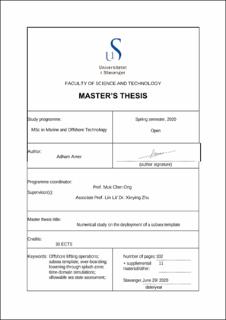| dc.contributor.advisor | Li, Lin | |
| dc.contributor.advisor | Zhu, Xinying | |
| dc.contributor.author | Amer, Adham | |
| dc.date.accessioned | 2020-09-18T12:52:53Z | |
| dc.date.available | 2020-09-18T12:52:53Z | |
| dc.date.issued | 2020-06-30 | |
| dc.identifier.uri | https://hdl.handle.net/11250/2678527 | |
| dc.description | Master's thesis in Offshore technology | en_US |
| dc.description.abstract | Subsea templates are normally transported to the installation site on the deck of a crane vessel. After being lifted off from the deck, the template is 1) over-boarded from the initial location to the target position by the side of the vessel; 2) lowered through the splash zone; 3) further lowered down to the seabed and 4) finally positioned and landed.
All the mentioned phases should be evaluated. The over-boarding phase has not been the focus of analysis due to a large involvement of human actions and little involvement of hydrodynamic effects. During offshore operations, the offshore manager may decide to decrease the defined installation weather criterion if the risk of the personnel safety on deck during the over-boarding phase is considered high. Thus, it is of a great need to quantify the operational criterion for such operation.
The splash zone crossing phase is also a critical phase of the installation process and must be analyzed to define the installation weather criterion. Furthermore, the shielding effect provided by the installation vessel must be accounted for in order to achieve an accurate assessment of the allowable sea state.
The objective of this study is to perform numerical analyses and define the allowable sea states for a safe over-boarding and splash-zone crossing operations when deploying subsea templates. A coupled numerical model of the vessel and the subsea template is constructed in SIMA-SIMO for each phase. The numerical analyses using time-domain simulations have been performed in various sea states.
For the over-boarding phase, tugger lines have been modeled to control the motions of the template during the operation. The pendulum motions of the subsea template are considered as the critical responses for the assessment of the allowable sea states for the over-boarding phase.
The allowable sea states limiting criteria for the splash-zone crossing include slack sling, snap loads in wires. The assessment is done with and without the shielding effect provided by the vessel. Different sensitivity studies including the influence of the wave direction, seed number, and sizing of the suction anchor are also addressed during the splash-zone crossing. | en_US |
| dc.language.iso | eng | en_US |
| dc.publisher | University of Stavanger, Norway | en_US |
| dc.relation.ispartofseries | Masteroppgave/UIS-TN-IMBM/2020; | |
| dc.subject | subsea template | en_US |
| dc.subject | over-boarding | en_US |
| dc.subject | lowering through splash-zone | en_US |
| dc.subject | time-domain simulations | en_US |
| dc.subject | allowable sea state assessment | en_US |
| dc.subject | offshore lifting operations | en_US |
| dc.subject | offshore teknologi | en_US |
| dc.title | Numerical study on the deployment of a subsea template | en_US |
| dc.type | Master thesis | en_US |
| dc.subject.nsi | VDP::Teknologi: 500::Marin teknologi: 580::Offshoreteknologi: 581 | en_US |
